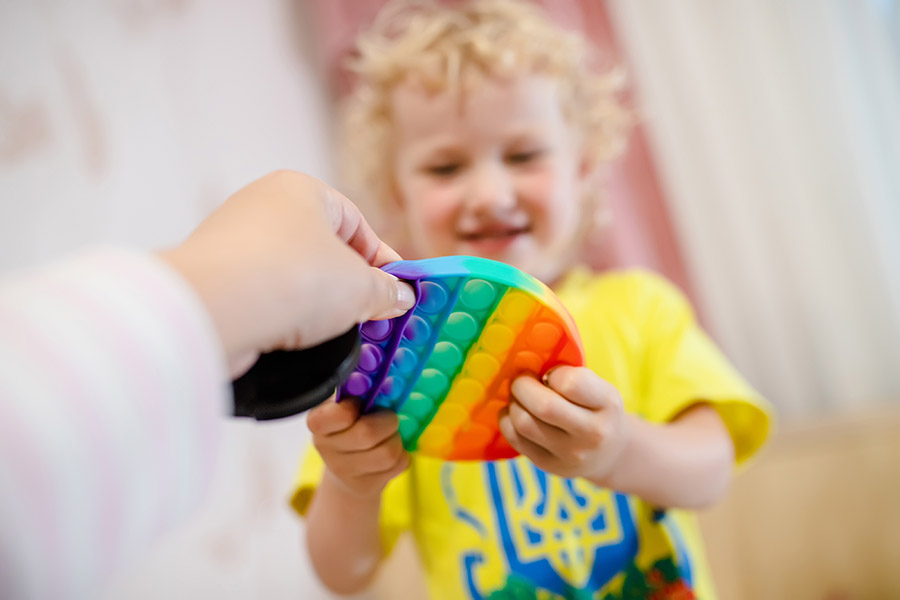As occupational therapists at Rock Therapeutic Services, we target sensory input + processing to optimize motor output & overall everyday function. We regulate their arousal level, assist children who are avoidant of sensory input, and increase their exposure and organization of that input. We help them to learn ways to vocalize what they’re feeling and learn coping strategies to increase their frustration tolerance.
What is Sensory Processing?
Did you know that there are eight senses? The five widely known senses are Smell/Olfactory, Vision, Auditory, Taste/Oral, and Touch. The three lesser knowns ones are proprioception, vestibular, and interoception.
Contact our Seattle Speech Therapists if you are interested in learning more about sensory processing and getting your child started with occupational therapy.


How We Can Help.
A few indicators of having difficulties with sensory processing:
Common Questions & Helpful FAQs
Is sensory processing disorder (SPD) a condition that is passed down from generation to generation?
According to the Sensory Processing Disorder foundation, preliminary research suggests that SPD is often inherited. Of course, as with any developmental and/or behavioral disorder, the causes of SPD are likely to be the result of factors that are both genetic and environmental. Only with more research will it be possible to identify the role of each.
How can I explain sensory processing disorders to other family members that ask?
Your friends and family members want to be supportive, but they may also not understand the sensory processing issues that your child is experiencing. To others, your child may look like they are being difficult and misbehaving – which is not the case. You can explain that your child’s behavior isn’t a choice. It is a reaction to what your child’s brain is telling them. Depending on the senses involved, you may also share whether your child is experiencing hyporesponsive or hyperresponsive dysfunction. It is best to share with others what helps your child when they experience sensory processing difficulties. It is important to remember that once your family members understand your child’s difficulties, they can offer you both more support.
How do I use sensory input strategies to help a child sit still at a table?
Your child may have difficulties sitting still if they have sensory processing difficulties or sensory processing disorder. Pediatric occupational therapists can work with your child to build the skills needed to complete activities at home and at school. A child’s inability to sit still can impact their attention,
regulation, and learning ability.
When at home, you and your child can implement a few strategies to help your child sit still at the table. Try the following, and implement the strategies that work well for your child in your daily routine:
Movement breaks are helpful for your child to periodically get out of their seats at the table and move around. They can get a drink of water, help set the table, or grab a snack from the pantry. Since the vestibular system (our sense of movement) affects our ability to attend to tasks, providing vestibular
input can help your child at the table.
Deep touch pressure from weighted items like a weighted blanket is also helpful to calm and help your child attend to a task at the table. Weighted items should be about 10% of the child’s body weight, and they should wear them for 20 minutes on and two or more hours off.
Sitting on a wiggle cushion provides tactile and vestibular input and can help a child sit in their seat during homework time!
What does it look like if my child is sensory seeking or sensory avoiding?
Our brains are constantly taking in information from our senses. For a child that has sensory processing difficulties, regulating the sensory input may be difficult for them.
A sensory seeker tends to underreact to sensory input or needs more input to function properly. Depending on the sensory input they are seeking, it can look different for each child.
A sensory-seeking child may exhibit the following behaviors:
- Standing too close when talking to others;
- Have an unusual tolerance for pain;
- Enjoy jumping, bumping, and crashing into things and people;
- Touch people and objects often;
- Seek out or make loud noises.
A sensory avoider is typically oversensitive to input and experiences it more intensely than the average person. Sensory avoiders refuse sensory input due to it being overwhelming to them.
A sensory-avoiding child may exhibit the following behaviors:
- Not liking to be hugged or kissed by family;
- Worry about being bumped in line by other kids;
- Refusing to wear tight, scratchy, or uncomfortable clothes;
- Have trouble knowing where their body is in relation to other people or objects.
Not all kids are sensory seekers or sensory avoiders. Some children may exhibit a combination of these or different reactions shared above. Their responses change and are dependent on their level of arousal and the abilities the child has to self-regulate.
What sensory activities can I provide my child at home?
Sensory bins are a great hands-on tactile experience in a contained storage container! The container should be large enough to let our child explore the items without spilling the filler out. You can theme the sensory bins for holidays, celebrations, or any themes tailored to your child’s interests. Sensory bins are a great way to engage your child while working on language development, play skills, and understanding their senses! You can hide items in filler items, like corn, beans, or water beads. The child can sift through the sensory bins to find the highly-motivating item within the sensory bin.
Finger painting is another tactile experience that supports sensory play! Messy play is important to every child’s development as it helps the body and brain integrate the information needed for spatial concepts, math, and language development. When a child finger paints, they learn how colors work; it improves fine motor development by strengthening finger and hand muscles, expresses feelings without words, and stimulates creativity and imagination!





